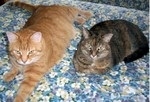Distilled Water
Distilled Water
Hi
Just got my first machine yesterday and have a few questions if anyone is up to it. It is a Respironics CFLEX Auto.
1. The manufacturer suggests distilled water. I notice, however, that the humidifier enters the air stream after the air has exited the machine, so no damage could really be caused the machine. How important is the use of distilled water.
2. My doctor says that I don't need to have the "AUTO" function turned on. He set it at a highest setting of 7.5 and the CFLEX at 3. Since I have the Auto function, wouldn't it be more optimal to use it than not?
Thanks for your help.
David
Just got my first machine yesterday and have a few questions if anyone is up to it. It is a Respironics CFLEX Auto.
1. The manufacturer suggests distilled water. I notice, however, that the humidifier enters the air stream after the air has exited the machine, so no damage could really be caused the machine. How important is the use of distilled water.
2. My doctor says that I don't need to have the "AUTO" function turned on. He set it at a highest setting of 7.5 and the CFLEX at 3. Since I have the Auto function, wouldn't it be more optimal to use it than not?
Thanks for your help.
David
Distilled water
Distilled water is quite important, not for the machine but for the water container. Without distilled water there will be a buildup of lime and scale and your humidifier will not last as long. I have had OSA for 3 years now and always use distilled water, unless I am away and unable to get it. My humidifier is like new.
_________________
| Machine: DreamStation Auto CPAP Machine |
| Mask: AirFit™ P10 Nasal Pillow CPAP Mask with Headgear |
| Humidifier: DreamStation Heated Humidifier |
| Additional Comments: Backups- FX Nano masks. Backup machine- Airmini auto travel cpap |
- WillSucceed
- Posts: 1031
- Joined: Sun Nov 07, 2004 7:52 am
- Location: Toronto, Ontario
I think Hawthorne is right -distilled water will prevent the build-up of mineral deposits in your humidifier tank.
There has been lots of debate on this forum about whether to dump the left over water each morning or, just leave the water in the tank and top it up each night.
My opinion is that you should follow the instruction given in the humidifier manual and DUMP THE WATER EVERY MORNING, allowing the humidifier tank to dry out during the day. Here's why:
1) Distilled water is NOT sterile.
2) Nasty things (bacteria, moulds, fungus, etc.,) can, and do, grow in warm, moist environments.
3) When the CPAP is not blowing, moisture from water in the tank is, to a small degree, finding its way back into the CPAP machine. Do you want moisture in your expensive CPAP machine?
4) Whatever is in the humidifier tank is being blown straight into your lungs while you are sleeping. For the sake of the cost of throwing out a bit of unused water, and the inconvenience of dumping the tank/refilling it, do you want to be breathing whatever nasty thing may have gotten into your tank and grew during the day/days that it sat there?
Some on this forum have complained about the cost of distilled water and object to throwing water out in the morning; fair enough, buying distilled is an expence. So, use a measuring cup and put an exact amount of water in the tank, 200mls, for example, and see how much is left in the morning. This will give you an idea of how much water you need during a night. In this way, you will figure out how much you need for a regular night and can then only put this amount in the tank. Also, you can microwave the water for 10-15 seconds before you put it in and, voila!, you get warm humidified air with your first breath.
Regarding your comment about using Auto or not, this is a big issue.
The auto function will give you a range of pressures during the night relative to what your needs are but, these pressure changes could cause some micro arousals that might disrupt your sleep. Set at non-Auto mode, your single pressure of 7.5 should (if your titration study was a good one) give you good treatment.
You could try several things:
1) Leave the machine set in single-pressure CPAP mode, pressure of 7.5, C-FLEX of 3, for several nights and see how you feel. Also, look at the data that you get from the Encore software and see how many events you are having that require a pressure higher of 7.5 to prevent.
2) Keep an eye on C-FLEX; not everyone likes it. If you find yourself waking with rapid breathing (panting) then C-FLEX might not be for you. Not to worry, C-FLEX is easily disabled and, at a pressure of 7.5, you are not too likely to need it and, it is not giving alot of exhalation pressure relief anyway. C-FLEX tends to give greater exhalation relief at higher pressures (>10).
OR
3) Turn on AutoPAP mode, with a pressure range 3 points above and 3 points below your titrated pressure (4.5 - 10.5) and see how you feel after several nights of use. Also, look at the data in Encore. Again, keep an eye on C-FLEX to see if you wake panting and/or feel any benefit from C-FLEX.
In all honesty, if you are essentially healthy, with no lung issues, a pressure of 7.5 is pretty low and should be easy to breath out against. Also, you should get used to it pretty easily. You may not need C-FLEX at all and, may not need the Auto function either.
Straight CPAP (non-auto) is the 'gold standard' for OSA treatment and your titrated pressure (7.5 for you) should prevent all of your events and, once you are accustomed to the 7.5 pressure, and have a mask that is comfortable for you with low leak, you should be able to sleep well with no micro-arousals.
Hope this helps.
There has been lots of debate on this forum about whether to dump the left over water each morning or, just leave the water in the tank and top it up each night.
My opinion is that you should follow the instruction given in the humidifier manual and DUMP THE WATER EVERY MORNING, allowing the humidifier tank to dry out during the day. Here's why:
1) Distilled water is NOT sterile.
2) Nasty things (bacteria, moulds, fungus, etc.,) can, and do, grow in warm, moist environments.
3) When the CPAP is not blowing, moisture from water in the tank is, to a small degree, finding its way back into the CPAP machine. Do you want moisture in your expensive CPAP machine?
4) Whatever is in the humidifier tank is being blown straight into your lungs while you are sleeping. For the sake of the cost of throwing out a bit of unused water, and the inconvenience of dumping the tank/refilling it, do you want to be breathing whatever nasty thing may have gotten into your tank and grew during the day/days that it sat there?
Some on this forum have complained about the cost of distilled water and object to throwing water out in the morning; fair enough, buying distilled is an expence. So, use a measuring cup and put an exact amount of water in the tank, 200mls, for example, and see how much is left in the morning. This will give you an idea of how much water you need during a night. In this way, you will figure out how much you need for a regular night and can then only put this amount in the tank. Also, you can microwave the water for 10-15 seconds before you put it in and, voila!, you get warm humidified air with your first breath.
Regarding your comment about using Auto or not, this is a big issue.
The auto function will give you a range of pressures during the night relative to what your needs are but, these pressure changes could cause some micro arousals that might disrupt your sleep. Set at non-Auto mode, your single pressure of 7.5 should (if your titration study was a good one) give you good treatment.
You could try several things:
1) Leave the machine set in single-pressure CPAP mode, pressure of 7.5, C-FLEX of 3, for several nights and see how you feel. Also, look at the data that you get from the Encore software and see how many events you are having that require a pressure higher of 7.5 to prevent.
2) Keep an eye on C-FLEX; not everyone likes it. If you find yourself waking with rapid breathing (panting) then C-FLEX might not be for you. Not to worry, C-FLEX is easily disabled and, at a pressure of 7.5, you are not too likely to need it and, it is not giving alot of exhalation pressure relief anyway. C-FLEX tends to give greater exhalation relief at higher pressures (>10).
OR
3) Turn on AutoPAP mode, with a pressure range 3 points above and 3 points below your titrated pressure (4.5 - 10.5) and see how you feel after several nights of use. Also, look at the data in Encore. Again, keep an eye on C-FLEX to see if you wake panting and/or feel any benefit from C-FLEX.
In all honesty, if you are essentially healthy, with no lung issues, a pressure of 7.5 is pretty low and should be easy to breath out against. Also, you should get used to it pretty easily. You may not need C-FLEX at all and, may not need the Auto function either.
Straight CPAP (non-auto) is the 'gold standard' for OSA treatment and your titrated pressure (7.5 for you) should prevent all of your events and, once you are accustomed to the 7.5 pressure, and have a mask that is comfortable for you with low leak, you should be able to sleep well with no micro-arousals.
Hope this helps.
Buy a new hat, drink a good wine, treat yourself, and someone you love, to a new bauble, live while you are alive... you never know when the mid-town bus is going to have your name written across its front bumper!
Distilled Water
Thanks WillSucceed. I had forgotten to mention that I too empty the water tank every day. I think this goes further to helping extend the life of your equipment. The distilled water is a lot cheaper than a new machine or heated humidity set up!
_________________
| Machine: DreamStation Auto CPAP Machine |
| Mask: AirFit™ P10 Nasal Pillow CPAP Mask with Headgear |
| Humidifier: DreamStation Heated Humidifier |
| Additional Comments: Backups- FX Nano masks. Backup machine- Airmini auto travel cpap |
-
Fatigue Fighter
- Posts: 118
- Joined: Fri Aug 26, 2005 8:24 pm
- Location: California
Oh yes! Use distilled water and dump it after every use. I do that even after naps. I wash the humidifier with regular water and liquid Ivory dishsoap after each use too and then I rinse it with distilled water so I don't have hard water spots.My opinion is that you should follow the instruction given in the humidifier manual and DUMP THE WATER EVERY MORNING, allowing the humidifier tank to dry out during the day. Here's why:
FF
- rested gal
- Posts: 12881
- Joined: Thu Sep 09, 2004 10:14 pm
- Location: Tennessee
Distilled water. I "add to" rather than dump it every day. Might be several weeks or more before I dump it, rinse out the chamber and start again. But always, always distilled water.
Very good suggestions from WillSucceed about ways to set your machine.
Another way to consider setting your machine (I'm not a doctor) would be to set it:
AFLE mode - that's auto with C-Flex mode.
C-Flex set at 1 or 2 or 3 - whichever feels smoothest to you...3 being the most reduction of pressure when you exhale.
Or set it in AUTO mode - which would be without C-Flex, if you don't like C-Flex at all.
7 for the Low pressure - essentially at your titrated pressure.
11 for the High pressure - to give some ceiling room for the occasions you might need more pressure for brief times during any given night.
While fixing the settings for your machine to run as an "autopap", be sure to set "RAMP" for 0 (zero.) Having "ramp" set for 0 is extremely important if you operate your REMstar in Auto mode or auto mode with C-Flex.
I think it may depend on how strongly a person exhales naturally, as to whether C-Flex is useful at various pressures that most of us tend to characterize as "low", "medium" or "high" pressures.
If your exhalations are quite shallow or light, C-Flex doesn't make much dent at all in pressures 13 and above.
If you have moderate to strong exhalations normally, you probably would feel the C-Flex difference on up into the low to mid teens and might not even notice it at all down at low pressures under 10.
How much good, if any, C-Flex would do for exhalation relief at pressures in the upper teens seems to be very dependent on how forcefully you normally breathe out, and especially how long the force is maintained throughout most of your exhalation.
C-Flex was not able to give me relief at all exhaling when I tried it at several straight high pressures like 16, on up to 19. My normal exhalation was not strong enough to make C-Flex reduce the pressure for more than a split second at the start of the exhale, then the higher pressure came roaring back in long before I was even halfway through trying to breathe out.
So, if "more than 10" means 11, 12, 13, 14 ...what most of us would call "moderate pressure"... yes, C-Flex can really shine there for most people. But if >10 also means 15 and on up towards 20, it becomes a very iffy proposition, imho, whether some people will have enough exhalation force to make C-Flex do much at all...or do the job long enough to give appreciable relief while trying to breathe out against a hurricane coming back in early. (Enter a bi-level machine, stage left....)
"Low" pressures of 6, 7, 8, 9 might seem so easy for most of us to breathe out against, we do tend to think, "Well, it's easy down there anyway, so C-Flex wouldn't be noticeable enough to add any comfort."
However, I think it depends on a person's natural exhalation force. Light, shallow breathers ((I'm one) can very much feel a nice pressure reduction difference when using C-Flex with pressures of 7, 8, 9 and 10.
It really is a very individual "comfort" thing...C-Flex. If it suits a person at all, it's very much a matter of how strongly a person's exhalation lasts, as to what relief they will get with C-Flex...at any pressure, high or low.
Very good suggestions from WillSucceed about ways to set your machine.
Another way to consider setting your machine (I'm not a doctor) would be to set it:
AFLE mode - that's auto with C-Flex mode.
C-Flex set at 1 or 2 or 3 - whichever feels smoothest to you...3 being the most reduction of pressure when you exhale.
Or set it in AUTO mode - which would be without C-Flex, if you don't like C-Flex at all.
7 for the Low pressure - essentially at your titrated pressure.
11 for the High pressure - to give some ceiling room for the occasions you might need more pressure for brief times during any given night.
While fixing the settings for your machine to run as an "autopap", be sure to set "RAMP" for 0 (zero.) Having "ramp" set for 0 is extremely important if you operate your REMstar in Auto mode or auto mode with C-Flex.
I think it may depend on how strongly a person exhales naturally, as to whether C-Flex is useful at various pressures that most of us tend to characterize as "low", "medium" or "high" pressures.
If your exhalations are quite shallow or light, C-Flex doesn't make much dent at all in pressures 13 and above.
If you have moderate to strong exhalations normally, you probably would feel the C-Flex difference on up into the low to mid teens and might not even notice it at all down at low pressures under 10.
How much good, if any, C-Flex would do for exhalation relief at pressures in the upper teens seems to be very dependent on how forcefully you normally breathe out, and especially how long the force is maintained throughout most of your exhalation.
C-Flex was not able to give me relief at all exhaling when I tried it at several straight high pressures like 16, on up to 19. My normal exhalation was not strong enough to make C-Flex reduce the pressure for more than a split second at the start of the exhale, then the higher pressure came roaring back in long before I was even halfway through trying to breathe out.
So, if "more than 10" means 11, 12, 13, 14 ...what most of us would call "moderate pressure"... yes, C-Flex can really shine there for most people. But if >10 also means 15 and on up towards 20, it becomes a very iffy proposition, imho, whether some people will have enough exhalation force to make C-Flex do much at all...or do the job long enough to give appreciable relief while trying to breathe out against a hurricane coming back in early. (Enter a bi-level machine, stage left....)
"Low" pressures of 6, 7, 8, 9 might seem so easy for most of us to breathe out against, we do tend to think, "Well, it's easy down there anyway, so C-Flex wouldn't be noticeable enough to add any comfort."
However, I think it depends on a person's natural exhalation force. Light, shallow breathers ((I'm one) can very much feel a nice pressure reduction difference when using C-Flex with pressures of 7, 8, 9 and 10.
It really is a very individual "comfort" thing...C-Flex. If it suits a person at all, it's very much a matter of how strongly a person's exhalation lasts, as to what relief they will get with C-Flex...at any pressure, high or low.
Wow! It has been very interesting reading the various replies to my initial message and I thank all of the posters. This has given me some serious food for thought. Right now, having just started with therapy, I am somewhat overwhelmed by the whole thing. Having to get used to the mask, breathing with a machine, the whole bit. I'm not sure where to start. So far I have been getting less sleep with the machine than I got without. So it is very hard to judge some of the fine points of CPAP therapy, like if I feel better in this mode or that mode. I feel like s--t anyway!
But I will definitely try out some of these ideas in time.
As for the distilled water - in the USA you can get a gallon for a little over a dollar. Here in Switzerland where I live people don't drink distilled water, so it is a specialized item for use in irons and car batteries and costs about a dollar a quart. Maybe a bit less. So it runs into quite a bit of money. But I suppose it will be worth it.
David
But I will definitely try out some of these ideas in time.
As for the distilled water - in the USA you can get a gallon for a little over a dollar. Here in Switzerland where I live people don't drink distilled water, so it is a specialized item for use in irons and car batteries and costs about a dollar a quart. Maybe a bit less. So it runs into quite a bit of money. But I suppose it will be worth it.
David
An alternative to distilled water that you can make at home (and is almost as good) is to bring some water to a boil for 5 minutes then cover and let cool. If you have hard water much of the dissolved minerals should now have fallen out of suspension and will be on the bottom of the pot. Carefully ladle or syphon the "improved" water off the top.
It won't be perfect, but it would be a big improvement over tap water.
It won't be perfect, but it would be a big improvement over tap water.
The CPAPer formerly known as WAFlowers
Distilled water
I don't use the humidifier for naps and I only wash my water chamber once a week. I use ordinary Ivory dishwashing liquid. You've read my other posts on this subject, so you know my other practices re the humidity.
_________________
| Machine: DreamStation Auto CPAP Machine |
| Mask: AirFit™ P10 Nasal Pillow CPAP Mask with Headgear |
| Humidifier: DreamStation Heated Humidifier |
| Additional Comments: Backups- FX Nano masks. Backup machine- Airmini auto travel cpap |














